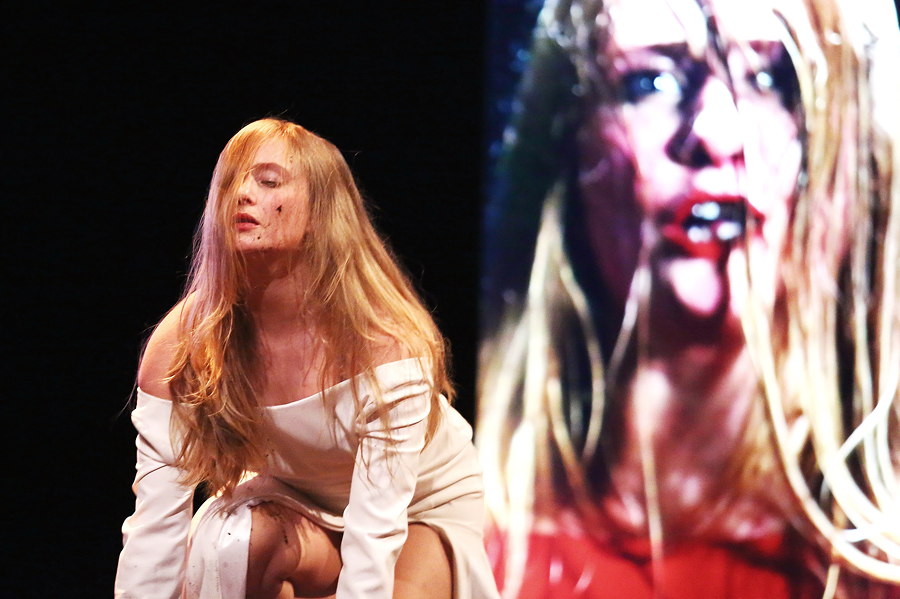Jan Fabre (Antwerp, 1958) is known at home and abroad as one of the most innovative and versatile artists of his generation. For almost 40 years, he has been creating work as a theatre maker, author, and visual artist. He pushes the boundaries in every genre he engages with. His great masterpiece came in 2015 with the acclaimed Mount Olympus - to glorify the cult of tragedy (a 24-hour performance). A monster production with 27 performers lasting a twenty four-hour period that thematizes Greek tragedies. With his newest creation Peak Mytikas (on the top of Mount Olympus) an 8-hour production, Jan Fabre continues the search of Greektragedies, focusing on the house of Thebes, the tragedies of Oedipus and Antigone. Peak Mytikas (on the top of Mount Olympus) illustrates his thinking about theatre: theatre as a total work of art in which the word is given a well considered, functional place alongside parameters such as dance, music, opera, performance elements and improvisation. The restraint with which Fabre uses text demands a new way of making theatre.
Theatre maker In the late 1970s, the still very young Jan Fabre caused a furore as a performance artist. His Money performances involved setting fire to bundles of money from the audience in order to make drawings with the ashes. In 1982, the work This is theatre like it was to be expected and foreseen placed a virtual bomb under the seat of the theatre establishment of the day. This was confirmed two years later with The power of theatrical madness commissioned for the Venice Biennale. Since then, Jan Fabre has grown to become one of the most versatile artists on the international stage. He makes a clean break with the conventions of contemporary theatre by introducing the concept of ‘real-time performance’ – sometimes called ‘living installations’ – and explores radical choreographic possibilities as a means of resurrecting classical dance. Fabre has been writing his own plays since 1975, although it was not until 1989 that they were first performed. His texts form an exceptional collection of miniatures, as it were, with a very open writing style and reflect Fabre’s concept of theatre as an all-encompassing form of art in which dialogue functions alongside other elements such as dance, music, opera, performance and improvisation. Chaos and discipline, repetition and madness, metamorphosis and the anonymous are all indispensible ingredients in Fabre’s theatre. The acuteness and reserve with which he employs language demand innovative solutions which have also appeared at the hand of other directors to have worked with his texts. Alongside age-old rituals and philosophical questions, Fabre also deals with such themes as violence, lust, beauty and erotica. The body in all its forms has been the subject of his investigations since the early 1980s. Jan Fabre (Antwerp, °1958) is a graduate of the Municipal Institute of Decorative Arts and the Royal Academy of Fine Arts. He is well known both at home and abroad as one of the most innovative and versatile artists of his generation. Over the past 30 years, he has produced works as a theatre maker, author and visual artist. Jan Fabre is renowned for expanding the horizons of every genre to which he applies his artistic vision.
Author Fabre’s plays were written with the aim of producing them on stage. In the early Seventies, Jan Fabre wrote to give shape to his then already intense imaginative world. These are plays which only came into the public domain many years later, when they were staged by the author himself. Other plays were created in the course of rehearsals on the basis of improvisation with the actors. In some cases they are a cobination of the author writings and improvised scripts. Several of these plays are monologues, often written for Fabre’s favourite actress Els Deceukelier. But the plays with several characters are striking for being like monologues too. One hardly ever finds realistic dialogues or anecdotes taken from life in Fabre’s theatre work. The plays are more conceptual in nature, and are poetic and materialise ancient rituals and themes that fascinate the author, as well as philosophical questions that obsess him. But we are just as likely to find the violence and pleasure of a life fully lived, the exuberant and sometimes dark experience of beauty, eroticism and festivity – elements in which Fabre may on one occasion be absorbed only to withdraw from it again on another. Jan Fabre’s literary work at the same time illustrates his thinking on theatre: theatre as an all embracing work of art in which the word is given a well-considered functional place next to such parameters as dance, music, opera, performance elements and improvisation. The austerity with which Fabre uses the medium of the word forces him to make theatre in an innovative way. When other directors work on these plays, they too are unable to distil any kind of conventional theatre out of them. And in recent years Jan Fabre’s plays have indeed been regularly performed by other companies.
Visual artist Jan Fabre’s work in the plastic arts is coordinated by Angelos (angels, messengers): this private company covers all the projects, from museum and gallery exhibitions, public and private commissions, to the publishing of catalogues and special editions. Angelos also acts as the producer of Fabre’s films and coordinates his performances. This makes it the point of contact for museums, galleries, freelance curators, publishers, collectors and journalists.
